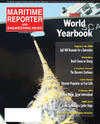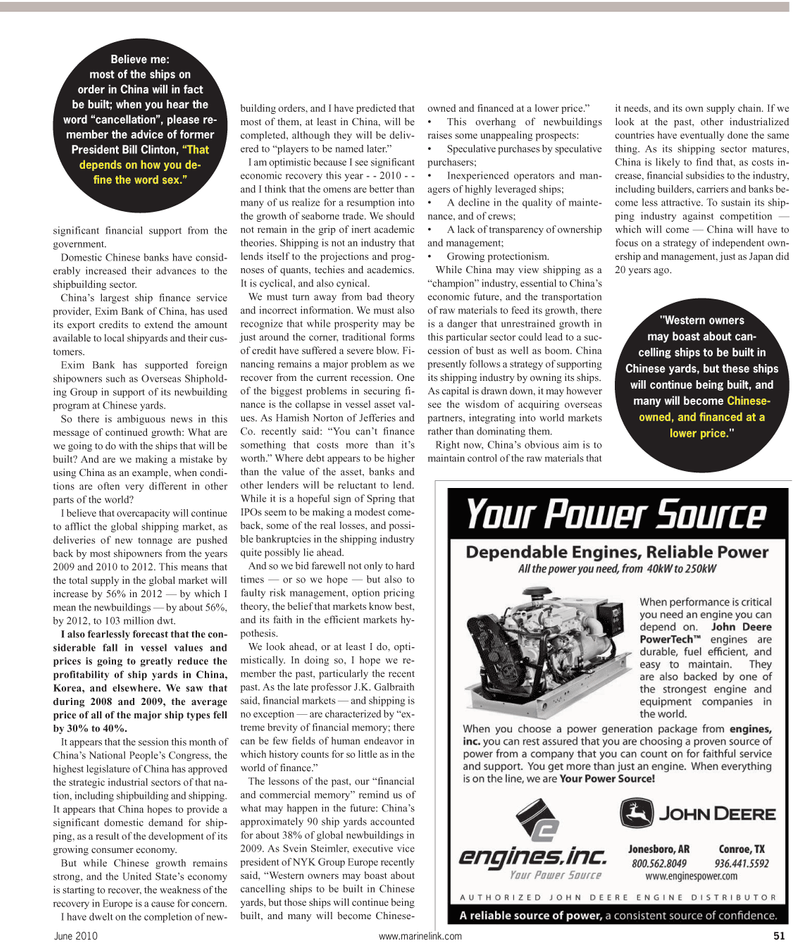
Page 51: of Maritime Reporter Magazine (June 2, 2010)
Read this page in Pdf, Flash or Html5 edition of June 2, 2010 Maritime Reporter Magazine
significant financial support from the government.
Domestic Chinese banks have consid- erably increased their advances to the shipbuilding sector.
China’s largest ship finance service provider, Exim Bank of China, has used its export credits to extend the amount available to local shipyards and their cus- tomers.
Exim Bank has supported foreign shipowners such as Overseas Shiphold- ing Group in support of its newbuilding program at Chinese yards.
So there is ambiguous news in this message of continued growth: What are we going to do with the ships that will be built? And are we making a mistake by using China as an example, when condi- tions are often very different in other parts of the world?
I believe that overcapacity will continue to afflict the global shipping market, as deliveries of new tonnage are pushed back by most shipowners from the years 2009 and 2010 to 2012. This means that the total supply in the global market will increase by 56% in 2012 — by which I mean the newbuildings — by about 56%, by 2012, to 103 million dwt.
I also fearlessly forecast that the con- siderable fall in vessel values and prices is going to greatly reduce the profitability of ship yards in China,
Korea, and elsewhere. We saw that during 2008 and 2009, the average price of all of the major ship types fell by 30% to 40%.
It appears that the session this month of
China’s National People’s Congress, the highest legislature of China has approved the strategic industrial sectors of that na- tion, including shipbuilding and shipping.
It appears that China hopes to provide a significant domestic demand for ship- ping, as a result of the development of its growing consumer economy.
But while Chinese growth remains strong, and the United State’s economy is starting to recover, the weakness of the recovery in Europe is a cause for concern.
I have dwelt on the completion of new- building orders, and I have predicted that most of them, at least in China, will be completed, although they will be deliv- ered to “players to be named later.”
I am optimistic because I see significant economic recovery this year - - 2010 - - and I think that the omens are better than many of us realize for a resumption into the growth of seaborne trade. We should not remain in the grip of inert academic theories. Shipping is not an industry that lends itself to the projections and prog- noses of quants, techies and academics.
It is cyclical, and also cynical.
We must turn away from bad theory and incorrect information. We must also recognize that while prosperity may be just around the corner, traditional forms of credit have suffered a severe blow. Fi- nancing remains a major problem as we recover from the current recession. One of the biggest problems in securing fi- nance is the collapse in vessel asset val- ues. As Hamish Norton of Jefferies and
Co. recently said: “You can’t finance something that costs more than it’s worth.” Where debt appears to be higher than the value of the asset, banks and other lenders will be reluctant to lend.
While it is a hopeful sign of Spring that
IPOs seem to be making a modest come- back, some of the real losses, and possi- ble bankruptcies in the shipping industry quite possibly lie ahead.
And so we bid farewell not only to hard times — or so we hope — but also to faulty risk management, option pricing theory, the belief that markets know best, and its faith in the efficient markets hy- pothesis.
We look ahead, or at least I do, opti- mistically. In doing so, I hope we re- member the past, particularly the recent past. As the late professor J.K. Galbraith said, financial markets — and shipping is no exception — are characterized by “ex- treme brevity of financial memory; there can be few fields of human endeavor in which history counts for so little as in the world of finance.”
The lessons of the past, our “financial and commercial memory” remind us of what may happen in the future: China’s approximately 90 ship yards accounted for about 38% of global newbuildings in 2009. As Svein Steimler, executive vice president of NYK Group Europe recently said, “Western owners may boast about cancelling ships to be built in Chinese yards, but those ships will continue being built, and many will become Chinese- owned and financed at a lower price.” • This overhang of newbuildings raises some unappealing prospects: • Speculative purchases by speculative purchasers; • Inexperienced operators and man- agers of highly leveraged ships; • A decline in the quality of mainte- nance, and of crews; • A lack of transparency of ownership and management; • Growing protectionism.
While China may view shipping as a “champion” industry, essential to China’s economic future, and the transportation of raw materials to feed its growth, there is a danger that unrestrained growth in this particular sector could lead to a suc- cession of bust as well as boom. China presently follows a strategy of supporting its shipping industry by owning its ships.
As capital is drawn down, it may however see the wisdom of acquiring overseas partners, integrating into world markets rather than dominating them.
Right now, China’s obvious aim is to maintain control of the raw materials that it needs, and its own supply chain. If we look at the past, other industrialized countries have eventually done the same thing. As its shipping sector matures,
China is likely to find that, as costs in- crease, financial subsidies to the industry, including builders, carriers and banks be- come less attractive. To sustain its ship- ping industry against competition — which will come — China will have to focus on a strategy of independent own- ership and management, just as Japan did 20 years ago.
June 2010 www.marinelink.com 51
Believe me: most of the ships on order in China will in fact be built; when you hear the word “cancellation”, please re- member the advice of former
President Bill Clinton, “That depends on how you de- fine the word sex.” "Western owners may boast about can- celling ships to be built in
Chinese yards, but these ships will continue being built, and many will become Chinese- owned, and financed at a lower price."

 50
50

 52
52
